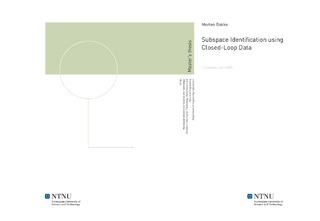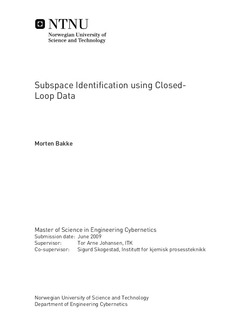| dc.contributor.advisor | Johansen, Tor Arne | nb_NO |
| dc.contributor.advisor | Skogestad, Sigurd | nb_NO |
| dc.contributor.author | Bakke, Morten | nb_NO |
| dc.date.accessioned | 2014-12-19T14:02:20Z | |
| dc.date.available | 2014-12-19T14:02:20Z | |
| dc.date.created | 2010-09-04 | nb_NO |
| dc.date.issued | 2009 | nb_NO |
| dc.identifier | 348878 | nb_NO |
| dc.identifier | ntnudaim:4485 | nb_NO |
| dc.identifier.uri | http://hdl.handle.net/11250/259921 | |
| dc.description.abstract | The purpose of this thesis was to investigate how different subspace identification methods cope with closed loop data, and how the controller parameters affect the quality of the acquired models. Three different subspace methods were subject for investigation; the MOESP method, the N4SID method and the DSR_e method. It is shown through a simulation example that all three subspace methods will identify the correct open-loop model from closed-loop data if the data record is noise-free (deterministic identification with perfect data). This result is not a new one, but a confirmation of the results from other researchers. Among the three different subspace methods that were investigated, the DSR_e method developed by dr. David Di Ruscio gave the best overall results. This method is especially designed to cope with closed-loop data, different from the MOESP and N4SID methods. Controller gain is shown to have a significant effect on the quality of the identified model when there is noise present in the loop. It is shown by simulations that up to a point, higher controller gain during the identification experiment actually gives more accurate open-loop models than models identified with lower controller gain. One of the reasons for this is that high gain tuning provides a higher signal to noise ratio through amplification of the reference signal, rendering the noise in the data used for identification less significant. Another reason may be that frequencies in the input signals will be more concentrated around the achievable bandwidth of the controller, which produces system outputs with more information of the frequency response around this bandwidth frequency. This is turn will reveal frequency information from the system that is important for control purposes. | nb_NO |
| dc.language | eng | nb_NO |
| dc.publisher | Institutt for teknisk kybernetikk | nb_NO |
| dc.subject | ntnudaim | no_NO |
| dc.subject | SIE3 teknisk kybernetikk | no_NO |
| dc.subject | Reguleringsteknikk | no_NO |
| dc.title | Subspace Identification using Closed-Loop Data | nb_NO |
| dc.type | Master thesis | nb_NO |
| dc.source.pagenumber | 109 | nb_NO |
| dc.contributor.department | Norges teknisk-naturvitenskapelige universitet, Fakultet for informasjonsteknologi, matematikk og elektroteknikk, Institutt for teknisk kybernetikk | nb_NO |

